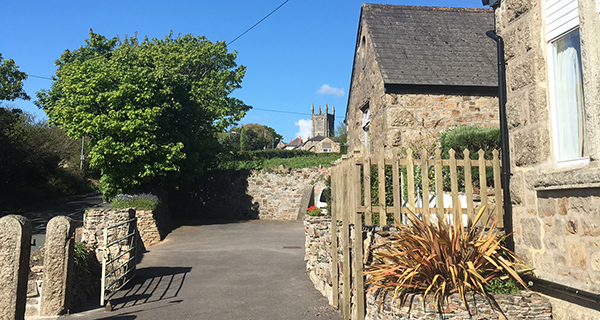Already associated in our minds with the famous Gilbert and Sullivan 1879 operetta The Pirates of Penzance, it’s also the last town of any size on the southwestern tip of the British isles.
I was alerted early on by my Cornish-born grandfather to its magnificent white sand beaches, mild, sunny weather, and a human culture that combined neolithic hill-fort ruins, pirate lore, palm trees and the promise of oceanic escape to the colonies.
This region of Cornwall, England, is famous today as the Cornish Riviera. Every summer, it’s the cottage, Airbnb, and small hotel escape of thousands of British residents seeking respite from rain, dreary interior landscapes and work.
Motivated by family history and an increasing desire to reconnect geographically with what my grandfather called “the Old Country,” my wife and I just spent three weeks in May exploring the old haunts.
We started in Penzance, after locating a wonderful accommodation on the web.
The Old Primary School (used until 1982) is a beautiful stone building (divided into two guest apartments) operated by Steve and Stacey Halfyard as a holiday let, in local parlance. It’s about 15 minutes by taxi from the Penzance train station, in the tiny hillside village of Ludgvan, some five minutes walk from the larger village centre of Crowlas.
Our plan was to get to know Cornwall on foot and not to rent a car. As it turned out, this was a brilliant concept.
After a brief spell of food shopping when we arrived in Penzance after a six-hour train ride from London, we cabbed up to Ludgvan and checked in. Tea and coffee and chocolate cookies were already available courtesy of the Halfyards.
I stood gazing out of the kitchen window and realized that several kilometres in the distance was an imposing castle on an island. My brain kicked in with the memory of the day’s preparatory reading on the train.
“That must be St. Michael’s Mount,” I suddenly realized. I looked closer and realized it was just losing its historic stone causeway connection to the mainland due to the rising tide.
The castle and its medieval church dedicated to St. Michael are plainly visible across Mount’s Bay from Penzance’s waterfront. They have their architectural origins in 1135, with extensive additions and restorations occurring in the 17th, 18th, 19th and 20th centuries.
The property is jointly administered by the National Trust and St. Aubyn Estates, whose family owns the castle.
The guide to the castle even contains a welcoming paragraph from Lord St. Levan, who advises in classic fashion: “The history of St. Michael’s Mount stretches back into the mists of time, but it is still home to me and my family, as well as some 30 other people who live and work on the island.”
For some naughty reason, Lord St. Levan appeared in my mind’s eye in the guise of John Cleese, looking his most aristocratic.
It was immediately obvious that our first walk down the hill from Ludgvan must be to St. Michael’s Mount.
At this point, we uncorked a bottle of Cornish red wine and popped two Cornish pasties (large meat-filled pastries with fork-crimped edges) we had bought that afternoon at Tesco into the microwave. Cornish home- made vanilla ice cream awaited us in the Old Primary School fridge.
We were both immensely happy to be exactly where we wanted to be at that moment.
The following morning after a breakfast of porridge and tea, we headed out the schoolhouse door to a day with beckoning blue sky and temperatures in the high teens celsius.
The first piece of our walk to Crowlas took us down a narrow, winding road through a hillside of medieval field systems, creatively divided by ancient hedgerows and occasional fieldstone walls.
Crows and magpies called to us, and on the grassy verges of the road brown rabbits darted about.
Every so often we walked by a grove of cedars, all purposefully planted in rows.
It was impossible to take a step in this ancient agricultural landscape without thinking about the very origins of farming and the role that the Cornish neolithic settlers played in establishing the practice in their homeland.
Next: Onwards to St. Michael’s Mount.
Troy Media columnist Mike Robinson has been CEO of three Canadian NGOs: the Arctic Institute of North America, the Glenbow Museum and the Bill Reid Gallery.
The views, opinions and positions expressed by columnists and contributors are the author’s alone. They do not inherently or expressly reflect the views, opinions and/or positions of our publication.







